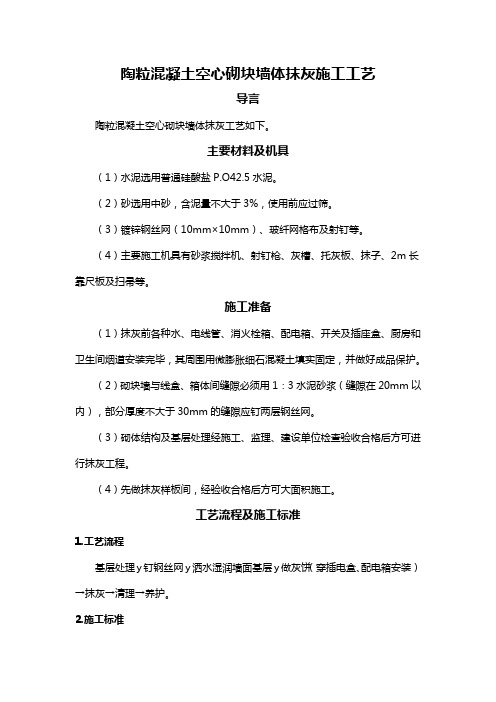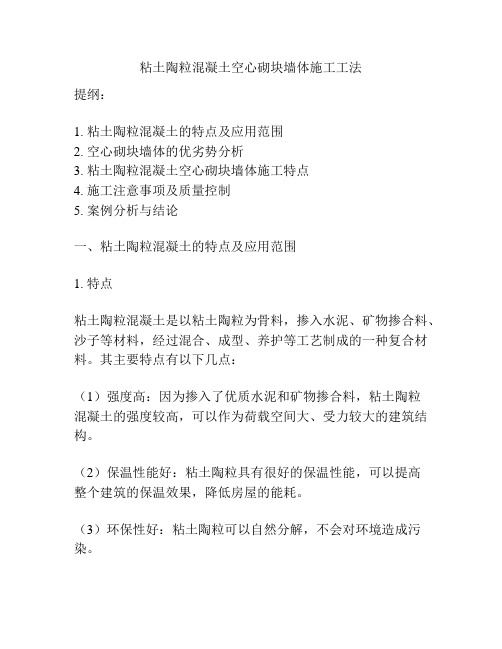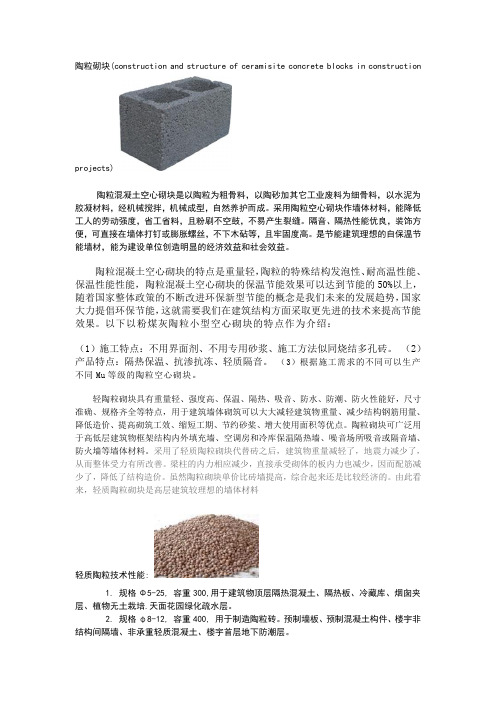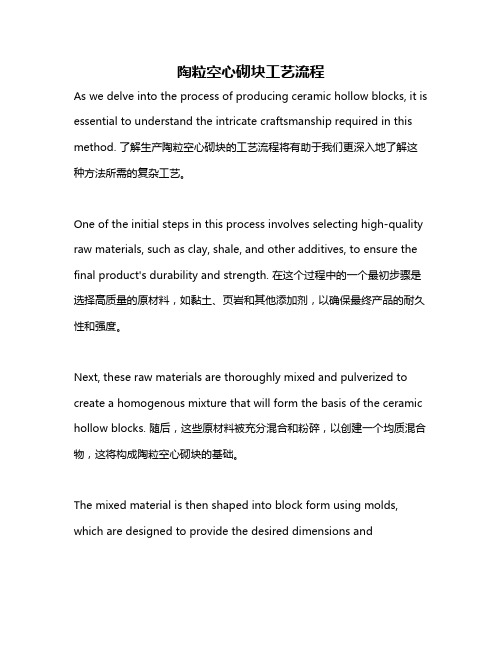陶粒混凝土空心砌块(Ceramsite concrete hollow block)
陶粒混凝土小型空心砌块与陶粒混凝土砖建筑技术规程

陶粒混凝土小型空心砌块与陶粒混凝土砖建筑技术规程1. 引言陶粒混凝土是一种特殊的建筑材料,它通过将陶粒与水泥、砂浆等混合物混合而成。
这种材料具有轻质、隔热、吸声等优点,因此在建筑行业中得到了广泛应用。
在本文中,我将探讨陶粒混凝土小型空心砌块和陶粒混凝土砖的建筑技术规程,并分享我对这个主题的个人观点和理解。
2. 陶粒混凝土小型空心砌块的技术规程2.1 原料选择在制作陶粒混凝土小型空心砌块时,首先需要选择合适的原材料。
常用的原料包括水泥、细砂、陶粒和掺合料等。
水泥是混凝土的骨架材料,细砂用于填充空隙,陶粒则提供了轻质和保温的特性。
掺合料可以改善混凝土的工作性能和强度。
2.2 配合比设计配合比设计是制作陶粒混凝土小型空心砌块的关键。
合理的配合比可以确保砌块的强度、轻质和保温效果。
一般来说,水泥和水的比例应适中,细砂和陶粒的比例也需要经过试验确定。
掺合料的添加量要根据实际情况来调整。
2.3 拌合工艺拌合工艺是制作陶粒混凝土小型空心砌块的关键环节。
在拌合过程中,应将水泥、细砂、陶粒和掺合料等材料进行充分混合,确保均匀分布。
注意控制水泥砂浆的粘度,以便更好地填充空心砌块的内部空隙。
2.4 材料预处理和成型在制作陶粒混凝土小型空心砌块之前,需要对原材料进行一些预处理工作。
对陶粒和细砂进行筛选和清洗。
成型工艺一般有压制、震动和浇筑等多种方式,具体方法应根据砌块的尺寸和要求进行选择。
2.5 养护和质量检测成型后的陶粒混凝土小型空心砌块需要进行养护。
一般来说,应将砌块放置在湿润环境中保持一定时间,以确保其强度和稳定性。
还需要进行质量检测,包括强度、吸水性和保温性能等方面的测试。
3. 陶粒混凝土砖的技术规程3.1 材料选择和原料处理与陶粒混凝土小型空心砌块相比,陶粒混凝土砖的制作过程更为复杂。
首先需要选择合适的材料,包括水泥、细砂、陶粒、掺合料和填充料等。
然后对这些原材料进行处理和筛选,以确保其质量和均一性。
3.2 配合比设计和拌合工艺配合比设计和拌合工艺在陶粒混凝土砖的制作中同样重要。
陶粒混凝土砌块

陶粒混凝土砌块陶粒混凝土砌块是一种新型的建筑材料,由粘结材料(水泥、石膏等)和填充材料(陶粒)混合而成。
陶粒混凝土砌块具有轻质、保温隔热、吸声降噪、抗震、环保等优点,被广泛应用于建筑领域,特别适用于高层建筑和框架结构。
陶粒混凝土砌块的生产工艺主要分为原料配比、制备混凝土砂浆、成型和养护四个步骤。
首先,原料配比是根据设计要求,确定陶粒与粘结材料的比例。
一般情况下,陶粒的体积占整个砌块体积的60%至75%。
通过合理的配比可以调整砌块的密度和性能。
接着,制备混凝土砂浆,将粘结材料与适量的水充分搅拌,加入陶粒并搅拌均匀。
混凝土砂浆的质量将直接影响到成品砌块的性能,所以搅拌的时间和速度需要控制得当。
然后,成型是将混凝土砂浆倒入模具中,用振动台震动使其均匀分布。
一般采用机械振动的方式,以确保砂浆充分填充模具内部,并去除气泡。
最后,养护是将砌块放置在适宜的环境中进行养护。
通常采取水养护的方式,即将砌块浸泡在水中,保证砂浆的养护时间和湿度。
养护时间一般为28天,以确保混凝土砂浆的强度和稳定性。
陶粒混凝土砌块的优点主要体现在以下几个方面:首先,轻质是陶粒混凝土砌块的一大特点,它的密度一般为400-800千克/立方米,比传统的砖、混凝土砌块轻很多。
这不仅可以减少结构的自重,提高大楼的自身稳定性,而且还可以减少施工中的劳动强度,提高施工效率。
其次,保温隔热性能好。
陶粒作为填充材料具有较高的孔隙率,可有效提高砌块的保温隔热性能,减少能量损耗。
与传统的砖和混凝土砌块相比,陶粒混凝土砌块的热传导系数只有它们的1/4至1/3,具有更好的保温效果。
另外,陶粒混凝土砌块具有良好的吸声降噪效果,适用于需要隔音的环境。
陶粒作为填充材料,可以有效地阻隔声波的传播,减少噪音的干扰,提供更舒适的工作和生活环境。
此外,陶粒混凝土砌块具有较好的抗震性能。
陶粒作为轻质填充材料,减小了砌块的重量,降低了结构的惯性力,增加了抗震性能,提高了建筑物的安全性。
陶粒混凝土空心砌块施工技术交1

陶粒混凝土空心砌块施工技术交1陶粒混凝土空心砌块施工技术交底一、工程概况:主厂房陶粒混凝土空心砌块隔墙厚度分别为300mm、250mm、200mm、150mm、100mm厚。
主厂房设计分别为外墙内墙。
砂浆采用M5水泥砂浆。
施工高度为+0.00至+33.0施工特点:砌体高度高,主要工程量集中在+0.00至13.00处。
二、作业条件: 1、施工机具准备:砂浆搅拌机、磅秤、手推车、胶皮管、筛子、铁锨、灰桶、喷水壶、皮数杆、托线板、线坠、水平尺、灰铲、线绳。
2、材料准备:1)、陶粒混凝土空心砌块强度等级≥MU2.0,密度≥0.8KN/m3,规格型号符合设计要求。
养护龄期必须达到28天,有出厂证明、检测合格证。
耐火等级大于180分钟。
2)水泥:采用32.5#普通硅酸盐水泥,有出厂证明,复试报告合格。
3)、砂:采用中砂,过5mm孔径筛子,含泥量不大于5%,不含杂物。
4)、标准机砖,有出场证明,复试检验报告合格。
5)、水:采用现场自来水。
6)、其他材料:拉结筋、预埋件、木砖等提前做好准备。
3、作业准备:1)、主体分部施工完毕,经相关部门验收合格。
2)、弹出轴线、墙边线、门窗洞口线,经复核验收。
3)、立皮数杆,皮数杆用30*40mm木料制作,皮数杆上注明门窗洞口、木砖、拉结筋、圈梁、配筋带的尺寸、标高。
皮数杆一般间距10米,转角处均设立皮数杆,一般距墙皮或墙角50mm为宜,皮数杆应垂直、牢固、标高一致,经复核合格后才能使用。
4)、根据最下面第一皮砖的标高,拉通线检查,如水平灰缝厚度超20mm,用混凝土找平,严禁用砂浆找平。
5)、陶粒混凝土砌块,砌筑前不需浇水湿润,砌块表面有浮水或受潮后,需干燥厚方可使用。
6)、砂浆配合比经试验确定。
准备好砂浆试模。
三、施工工艺: 1、工艺流程浇筑砼带及柱施工准备拌制砂浆排砖搁地砌砖浇筑砼带及柱清理自检、评定2、施工计划(见具体施工周报)3、施工步骤1)、陶粒混凝土空心砌块施工前将楼面清理干净,剔除表面灰浆,每层楼层要在地(楼)面弹出墙身线,门窗洞口位置线,经复核复核图纸要求后,方可进行下到工序施工。
陶粒混凝土空心砌块

水泥为胶凝材料、经机械搅拌、机械模 具成型
01 产品特点
03 工艺流程
目录
02 工艺原理 04 操作要点
陶粒混凝土砌块是以陶粒为粗骨料,以陶砂加细骨料,以水泥为胶凝材料,经机械搅拌,机械模具成型,自 然养护而成。、产生裂缝。隔音、隔热性能优良,装饰方便,可直接在墙体打钉或膨胀螺丝,不下木砧等,且牢 固度高。是节能建筑理想的自保温节能墙材,能为建设单位创造明显的经济效益和社会效益。陶粒砌块和加气混 凝土砌块都是轻集料砌块;,加气混凝土砌块是实心的;加气混凝土砌块导热系数要比陶粒砌块导热系数小得多。
产品特点
●外墙传热系数和聚苯板厚度选用 ●窗口保温 门窗洞口侧面应做适当保温处理(如贴较薄的聚苯板,或抹聚苯颗粒浆料等)。窗台板应符合使用安全的要 求。应严格按照设计要求施工。 ●伸缩缝和装饰缝 各生产厂的产品都有相应的最大伸缩缝间距,应同建筑设计师协调好伸缩缝和装饰缝的具体位置。 ●联结安全度核算 在外保温施工中,保温材料与墙体基面的联结主要有粘结和粘锚结合以粘为主等两种方式。如果采用锚固为 主的方式,应做可靠的个体工程安全度设计。 对高层建筑,标高在20m以上的部位,宜增设机械锚固件,以提高联结安全度。锚固件数量:标高在50m以下 的不宜少于4个/m2;标高在50m以上的不宜少于6个/m2。 对轻质材料墙体,以及既有建筑的墙体保温改造,必须对胶粘剂与墙体基面的粘结强度或机械锚固件的拔出 力
感谢观看
3、在陶粒混凝土空心砌块墙体与混凝土结构接触界面、开槽开孔处以及洞口周边设置钢丝片,防止墙体粉刷 层产生龟裂纹。
4、采取必要的构造措施,如加设构造柱、适量配置通长钢筋以增加墙体的整体性能和抵抗温度收缩应力。
工艺流程
施工准备→基层清理→分中弹线→立皮数杆→设置墙体拉结钢筋→第一皮砖放样→墙体组砌→粉刷前节点处 理→墙面粉刷。
陶粒混凝土空心砌块耐火极限_概述及解释说明

陶粒混凝土空心砌块耐火极限概述及解释说明1. 引言1.1 概述陶粒混凝土空心砌块是一种新型的建筑材料,具有轻质、保温、隔热等优点,被广泛应用于建筑领域。
耐火极限作为衡量材料抗高温性能的重要指标之一,对于确保建筑物在火灾中的安全性至关重要。
本文将着重介绍陶粒混凝土空心砌块的耐火极限及其相关内容。
1.2 文章结构本文分为五个主要部分。
首先,引言部分将介绍文章的背景和目的。
其次,在“陶粒混凝土空心砌块耐火极限”一节中,将对陶粒混凝土空心砌块进行定义和特点的阐述,并解释耐火极限概念及其意义,并探讨影响耐火极限的因素。
第三部分将介绍各种常见的耐火极限测试方法和相关标准,并展望实际应用和发展趋势。
接下来,在“陶粒混凝土空心砌块的耐火性能提升措施”一节中,将探讨提高陶粒混凝土空心砌块耐火性能的材料层面上的改进措施、结构设计上的优化策略以及施工质量管理和监测手段。
最后,在结论部分对研究结果进行总结与归纳,并提出未来进一步研究方向的建议。
1.3 目的本文旨在全面介绍陶粒混凝土空心砌块耐火极限的概念、测试方法和标准,解析影响其耐火性能的因素,并提出提升其耐火性能的有效措施。
通过本文的阐述,旨在为相关领域从业人员和研究者提供有关陶粒混凝土空心砌块耐火性能的详尽了解,并促进该建材领域的发展与创新。
2. 陶粒混凝土空心砌块耐火极限2.1 陶粒混凝土空心砌块的定义和特点陶粒混凝土空心砌块是一种具有较低密度、高保温性能和良好耐火性能的建筑材料。
它采用陶粒与水泥、矿渣等胶凝材料进行混合,再通过模具成型制作而成。
由于其结构中存在大量的气孔,使得该材料具有较低的导热系数和导音系数,从而达到了良好的保温效果。
2.2 耐火极限的概念和意义耐火极限是指材料在经受高温条件下能够保持原始形态和功能的时间。
对于陶粒混凝土空心砌块来说,耐火极限是评估其在火灾发生时抵抗高温侵蚀的能力。
耐火极限不仅体现了该材料的阻燃性能,还直接影响建筑物在遭受火灾时的安全性和持久性。
陶粒混凝土空心砌块技术交底

3.3允许偏差:
项次
项目
允许偏差(mm)
检查方法
1
轴线位移
10
经纬仪或拉线尺量检查
2
墙体顶面标高
±15
水准仪和尺量检查
每层
5
用2m托线板检查
3
垂直度
≤10m
10
用经纬仪或吊线、尺量检查
>10m
20
4
表面平整度
8
用2m靠尺,楔形尺检查
5
水平灰缝平直度
1.2.2水泥:采用P.C32.5复合硅酸盐水泥,有出厂证明、复试报告。
1.2.3砂:采用中砂,过5mm孔径筛子,砂含泥量不超过5%,不含草根等杂物。
1.2.4混合砂浆掺合料:选用砂浆王。
1.2.5水:采用自来水。
1.2.6其它材料:拉结钢筋、预埋件、等,提前做好防腐处理。
1.3作业准备
1.3.1主体分部中承重结构已施工完毕,经相关部门验收合格。
1.3.2弹出轴线、墙边线、门窗洞口线,经复核,办理预检手续。
1.3.3立皮数杆:皮数杆用30mm×40mm木料制作,皮数杆上注明门窗洞口、拉结筋、圈梁、过梁、配筋带的尺寸标高。皮数杆一般间距10m,转角处均应设立,皮数杆一般距墙皮或墙角50mm为宜。皮数杆应垂直、牢固、标高一致,经复核,办理预检手续。
2.5.12与构造柱、抱框柱相连部位陶粒混凝土空心砌块排块时,应留置马牙槎,二退二进,先退后进。(见下图)
2.5.13、陶粒砖墙中的各种预留孔、洞及埋件,应按设计标高、位置和尺寸准确留置,避免凿墙打洞,专业安装的墙中预留管,在砌筑过程中及时预埋,严禁在墙上乱凿乱剔槽,破坏墙体的整体稳定性。安装电盒、配电箱的砌块应用混凝土灌实,将电盒、配电箱固定牢固。
陶粒混凝土空心砌块墙体抹灰施工工艺

陶粒混凝土空心砌块墙体抹灰施工工艺导言陶粒混凝土空心砌块墙体抹灰工艺如下。
主要材料及机具(1)水泥选用普通硅酸盐P.O42.5水泥。
(2)砂选用中砂,含泥量不大于3%,使用前应过筛。
(3)镀锌钢丝网(10mm×10mm)、玻纤网格布及射钉等。
(4)主要施工机具有砂浆搅拌机、射钉枪、灰槽、托灰板、抹子、2m长靠尺板及扫帚等。
施工准备(1)抹灰前各种水、电线管、消火栓箱、配电箱、开关及插座盒、厨房和卫生间烟道安装完毕,其周围用微膨胀细石混凝土填实固定,并做好成品保护。
(2)砌块墙与线盒、箱体间缝隙必须用1:3水泥砂浆(缝隙在20mm以内),部分厚度不大于30mm的缝隙应钉两层钢丝网。
(3)砌体结构及基层处理经施工、监理、建设单位检查验收合格后方可进行抹灰工程。
(4)先做抹灰样板间,经验收合格后方可大面积施工。
工艺流程及施工标准1.工艺流程基层处理y钉钢丝网y洒水湿润墙面基层y做灰饼(穿插电盒、配电箱安装)→抹灰→清理→养护。
2.施工标准(1)抹灰前基层表面的尘土、油垢及油渍等清除干净并洒水湿润。
顶棚抹灰时,先抹1层掺801胶素浆,随抹随打底灰。
(2)所有内墙面满挂10mm×10mm钢丝网,每边搭接宽度不小于100mm。
(3)砌块墙与混凝土梁板和烟道与墙体的交接处、90mm隔墙与墙体、抹灰接槎处及各种盒、洞、箱周边和背面等部位设加强钢丝网,宽度不小于200mm (保证不同基质钢丝网的覆着宽度不小于100mm)。
(4)门窗洞口处沿洞口角45。
粘贴500mm长玻纤网(在钢丝网上面),玻纤网用水泥掺801胶粘贴(图1)。
图1 门洞口粘结玻纤网(5)贴灰饼。
先用托线板全面检查墙面的平整度,根据检查情况并兼顾抹灰总体平均厚度,决定墙面抹灰厚度。
(6)抹灰。
抹灰时不得一次抹过厚或一次成活,由于抹灰层内外收水程度快慢不同,易产生开裂,甚至起鼓脱落。
抹灰层厚度每遍以7~9mm为宜。
待前一层抹灰层凝结后,方可进行第2层抹灰,用铁抹子压实。
陶粒混凝土空心砌块

5.2.6 砌筑方法按照改进的组砌操作方法施工,水平缝铺灰厚度为20mm左右,以保证有8-10mm嵌入砌块孔内形成结合销键。
5.2.7 墙体垂直度控制:采用线坠法进行控制。
5.2.8 砂浆饱满度:水平灰缝采用挤压法施工,端缝采用填浆法施工。
砌筑砂浆强度指标:不低于M7.5,与砌块强度等级保持一致。
20×20细目钢丝网片、水泥钢钉、φ6钢筋。
7 机具设备
计量器具1套,砂浆搅拌机1台,切割机2台,水准仪一台,皮数杆4根,15m钢尺1把,5米钢卷尺4把,冲击电钻1台,砂浆试模3套,砌刀、架凳及灰桶若干。
8 劳动组织及安全
5.3.2 用于“错缝”的砌块采用实心砌块。
5.3.3 墙中有水平预埋管道处的砌块采用带“凹”槽的砌块砌筑。
5.3.4 墙中拉结钢筋设置:高度方向的间距为φ6@500mm,沿墙通长布置,其搭接长度为45d,与主体结构可靠连接,拉结钢筋布置在砌块的盲孔面,且应在满铺水泥砂浆后放置钢筋,拉结钢筋上部砌筑实心配块,墙体转角处加设1φ6转角构造钢筋,如图2所示。
9.3.1 抹灰工程施工前应作好隐蔽工程验收,对界面、洞口周边、开槽开孔处的钢丝网片进行检查、隐蔽。
9.3.2 向操作工进行粉刷砂浆配合比、操作要点、质量标准及其它注意事项的技术交底。
9.3.3 抹灰施工应分层进行,每层厚度为5~8mm。一般抹灰按高级要求组织实施,其允许偏差和检验方法如表2:
4.3 在砌块墙体与混凝土结构接触界面、开槽开孔处以及洞口周边设置钢丝网片,防止墙体粉刷层产生龟裂纹。
4.4 采取必要的构造措施,如加设构造柱、适量配置通长钢筋以增加墙体的整体性能和抵抗温度收缩应力。
陶粒混凝土空心砌块强度

陶粒混凝土空心砌块强度:MU2.5、3.5、5.0和7.5,容重:小于1200KG/M3 比较其他轻质墙材具有以下优势:墙体更稳固,增强建筑的抗震性能,使用更安全;墙面规整,装修时无需找平层;砌块密实度高,因此吸水率低、收缩率小,墙体不易出现裂缝;砌块密实度高,耐撞击,便于安装附件时切割钻孔;砌块密实度高且强度稳定,可在砌体内设置水平、竖向配筋,替代现浇构造壁柱和过梁,提高施工效率,降低综合造价;做为厂房内防火墙,防火性能好;装修时可直接涂料,装饰效果实用、耐久,综合造价低;保温、隔声、防潮性能好,并且可组合成复合墙,满足各种高标准要求;墙体内可走暗管线(水暖、电气、电讯等)加气混凝土的种类加气混凝土产品品种可分为非承重砌块、承重砌块、保温块、墙板与屋面板五种。
其中,非承重砌块生产和使用最为广泛,它的体积密度一般为500 kg/m3和600 kg/m3,主要使用在结构中的填充墙与隔墙,而不承担荷载;承重砌块的体积密度为700 kg/m3和800 kg/m3,在建筑中经特殊结构处理后承担荷载;保温块的体积密度一般为300 kg/m3和400 kg/m3,主要用于建筑物保温隔热、屋面板和墙板都是加筋加气混凝土板,根据用途不同,其配筋不同。
四、加气混凝土原材料的质量要求1、粉煤灰粉煤灰是本产品的核心原料,也是加气混凝土硅铝成分的主要来源。
应符合(JC409-91)标准(见下表)等级项目Ⅰ级Ⅱ级Ⅲ级细度(0.045mm方孔筛筛余)≤ 30% 45% 55% 标准稠度需水量≤ 50% 58% 60% 烧失量≤ 7% 12% 15% Si O2 ≥ 40% 40% 40% S O3 ≤ 2% 2% 2% 以上质量要求适用于普通粉煤灰(CaO≤10%). 2、水泥水泥是粉煤灰加气混凝土强度的主要来源。
它为加气混凝土提供了主要的钙质材料。
适用于生产粉煤灰加气混凝土的水泥,主要应以水泥的品种和标号两个方面选择。
在生产中首先应该选用52.5级普通硅酸盐水泥。
陶粒空心砌块施工工法

陶粒空心砌块施工工法一、引言陶粒空心砌块是一种种植蔬菜、花卉和树木的理想材料。
它由陶粒和水泥制成,具有轻质、保温、隔音和透气等优点。
在施工过程中,正确的工法是确保空心砌块稳定性和使用寿命的关键。
本文将介绍陶粒空心砌块施工的一些基本工法。
二、材料准备在开始施工之前,准备好必要的材料是至关重要的。
除了陶粒空心砌块本身,还需要水泥、砂浆、石膏、钢筋和工具(如搅拌机、铲子、水平仪等)。
三、基础处理在进行陶粒空心砌块的施工之前,首先要对基础进行处理。
清除基础表面上的杂物和污垢,并确保其平整、牢固。
在基础上涂抹一层砂浆,以增强陶粒空心砌块的粘结力。
四、砌块布置将陶粒空心砌块按照设计要求而排列。
注意在砌块之间使用砂浆进行填充,以增加其稳定性。
同时要确保砌块之间的间隙一致,并用水平仪进行检查,以保证整体水平。
五、搭建支撑结构在砌块布置完成后,必要时搭建支撑结构以加固整个砌块体系。
可以使用金属支架、木杆或其他材料进行支撑。
确保支撑结构稳定可靠,能够承受砌块的重量和外部压力。
六、填充砂浆在砌块布置和支撑结构搭建完成后,需要填充砂浆以加固空心砌块。
使用搅拌机将水泥和砂浆充分混合,然后用铲子将混合好的砂浆填充到空心砌块中。
确保填充均匀,并用木棒或震动器震实砂浆,去除空气泡。
七、后续处理在填充砂浆完成后,等待砂浆充分干燥,通常需要几天的时间。
在此期间,需要定期对砂浆进行湿润处理,以避免其过快干燥引起。
陶粒混凝土空心砌块砌筑及抹灰施工方法.

1 前言陶粒混凝土空心砌块是目前国内大力推广应用的一种新型墙体材料,由于它具有容重轻、保温、防火、吸音、抗震性能好,以及利用工业废渣,变废为宝、节能节地等特点,近年来得到了较为广泛的应用。
由于此种砌块的特性,施工应用不当也会产生砌体及抹灰裂缝等质量通病。
为了进一步完善该墙体材料的砌筑及抹灰工艺,保证施工质量。
2 施工特点陶粒混凝土空心砌块是以陶粒为粗骨料,以膨胀珍珠岩为细骨料,以水泥为胶凝材料,经机械搅拌、机械成型、自然养护而成。
它具有防火、质轻、高强、隔热、防潮等优点。
其干缩率与砂浆接近且表面凸凹粗糙不平,易与抹灰层结合,可有效减少空鼓、裂缝现象;另外抹灰前无需甩浆,可减少操作工序,加快施工进度。
3 适用范围适用于多层及高层建筑的填充墙及外围护墙。
4 工艺原理4.0.1 砌块提前进场预干缩,释放干缩应力,使砌块体积基本稳定;墙体砌筑时,在梁、柱与砌体交接处设控制缝,释放砌体残余收缩应力。
4.0.2 砌体抹灰时,在砌体与梁、柱连接处铺钉防裂钢丝网片或设置玻纤网格布,在施工洞口及各类箱体后背加设钢丝网,采用分层抹灰并控制分层抹灰厚度,使抹灰层粘结牢固,防止干缩、湿度及温度变形所引起的开裂。
5 施工工艺流程及操作要点5.1 施工工艺流程基层清理、放线→墙体拉结筋及圈梁(过梁)植筋→立皮数杆→基层表面清理、湿润→排列砌块→拉线→砂浆拌制→砌筑→勾缝→安装管线敷设→质量验收→基层处理→浇水湿润墙面→吊直、套方、找规矩→贴灰饼→墙面冲筋→阳角护角→抹底灰→抹中层灰→抹罩面灰→浇水养护5.2 操作要点5.2.1 基层清理、放线:将墙体部位的楼地面,剔除高出地面的凝结灰浆,并清理干净,浇水湿润。
砌体施工前,应将基础面用1:2水泥砂浆或C15细石混凝土按标高找平,依据施工图放出墙体的边线和洞口线。
5.2.2 植筋:为保证墙体拉结筋和圈梁(过梁)的正确定位,确保工程质量,墙体拉结筋和圈梁(过梁)钢筋宜采用后植筋处理,墙体拉结筋采用2Φ6@600,拉结筋伸入墙内不小于1m,且不小于墙长的1/5,植筋深度为15d。
粘土陶粒混凝土空心砌块墙体施工工法

粘土陶粒混凝土空心砌块墙体施工工法提纲:1. 粘土陶粒混凝土的特点及应用范围2. 空心砌块墙体的优劣势分析3. 粘土陶粒混凝土空心砌块墙体施工特点4. 施工注意事项及质量控制5. 案例分析与结论一、粘土陶粒混凝土的特点及应用范围1. 特点粘土陶粒混凝土是以粘土陶粒为骨料,掺入水泥、矿物掺合料、沙子等材料,经过混合、成型、养护等工艺制成的一种复合材料。
其主要特点有以下几点:(1)强度高:因为掺入了优质水泥和矿物掺合料,粘土陶粒混凝土的强度较高,可以作为荷载空间大、受力较大的建筑结构。
(2)保温性能好:粘土陶粒具有很好的保温性能,可以提高整个建筑的保温效果,降低房屋的能耗。
(3)环保性好:粘土陶粒可以自然分解,不会对环境造成污染。
(4)耐火性强:粘土陶粒混凝土的耐火等级可以达到A级,具有良好的防火性能。
(5)可塑性好:粘土陶粒混凝土可以制成各种形状的构件,适用于各种建筑结构。
2. 应用范围作为一种新型的建筑材料,粘土陶粒混凝土的应用范围广泛,主要包括以下几个方面:(1)作为承重墙体:因为其强度高、保温性能好,并且可以制成各种形状的构件,可以用来作为承重墙体结构。
(2)作为隔墙材料:粘土陶粒混凝土可以制成均匀规整的空心砌块,适用于隔墙的施工。
(3)作为楼板材料:对于小跨度的楼板,可以使用粘土陶粒混凝土材料,因为其质轻,易于施工。
(4)作为防火材料:由于粘土陶粒混凝土的耐火性强,可以应用于防火隔断的建设。
(5)应用于景观建筑:由于粘土陶粒混凝土的色彩丰富、可塑性好,可以应用于景观建筑的建造。
二、空心砌块墙体的优劣势分析1. 优势(1)重量轻:空心砌块由于中间有空洞,重量较轻,便于施工。
(2)保温性好:由于中间有空洞,空心砌块对保温性能的提升很明显,可以减少室内外温度差异,达到节能的目的。
(3)隔音效果好:由于中间有空洞,空心砌块对于隔音效果的提升也很明显。
(4)施工周期短:由于空心砌块的重量轻、施工方便,可以缩短施工周期,提高施工效率。
陶粒砼空心砖砌筑

陶粒混凝土空心砌块是以陶粒为粗骨料,以陶砂加其它工业废料为细骨料,以水泥为胶凝材料,经机械搅拌,机械成型,自然养护而成。
采用陶粒空心砌块作墙体材料,能降低工人的劳动强度,省工省料,且粉刷不空鼓,不易产生裂缝。
隔音、隔热性能优良,装饰方便,可直接在墙体打钉或膨胀螺丝,不下木砧等,且牢固度高。
是节能建筑理想的自保温节能墙材,能为建设单位创造明显的经济效益和社会效益。
砌块建筑施工与砖混建筑施工有许多相似之处,其特殊的质量控制点主要在于正确使用各种块型、保证灰缝砂浆与灌孔混凝土饱满并与砌块密实粘结、防止砌块受潮发生变形等。
一、陶粒砼空心砖砌筑1、主要材料准备:水泥:用P.O32.5(普通硅酸盐水泥)或P.S32.5(矿渣硅酸盐水泥),有出厂证明、复试报告。
砂:宜用中砂或细砂,过5mm孔径筛子,砂含泥量不超过5%,并不含草根等杂物。
水:用自来水或不含有害物质的洁净水,应符合《混凝土拌合用水标准》JGJ63的规定。
其它材料:墙体拉结钢筋。
2、现场组织:弹出轴线,墙边线、门窗洞口线,经复核,办理预检手续。
立皮数杆:采用30*40mm木料制作,皮数杆上注明门窗洞口、木砖、拉结筋、圈梁、过梁的尺寸标高。
皮数杆间距5-10m,转角处均应设立,一般距墙皮或墙角50mm为宜。
皮数杆应垂直、牢固、标高一致。
根据最下层一皮砖的标高,拉通线检查。
如水平灰缝厚度超过20mm,用细混凝土找平,不得用砂浆找平或砖包裹砂浆找平。
干砖使用时,应提前1~2天浇水湿润,粘土砖以水浸入砖四边1.5cm,含水↓3)根据图纸各部位尺寸,排砖撂底,使组砌方法合理,便于操作。
4)制备砂浆:a.砂浆配合比经试验室确定,应用重量比,计量精度为:水泥±2%,砂及掺合料±5%。
b.采用机械搅拌,投料顺序为砂—水泥—掺合料—水,搅拌时间不少于1.5min。
c.砂浆应随拌随用,水泥或水泥混合砂浆一般在拌合3—4小时内用完,严禁用过夜砂浆。
d.每天砌筑高度不应大于1.8m.应提前洇水,干块不得上墙。
陶粒混凝土空心砌块强度

陶粒混凝土空心砌块强度:MU2.5、3.5、5.0和7.5,容重:小于1200K G/M3 比较其他轻质墙材具有以下优势:墙体更稳固,增强建筑的抗震性能,使用更安全;墙面规整,装修时无需找平层;砌块密实度高,因此吸水率低、收缩率小,墙体不易出现裂缝;砌块密实度高,耐撞击,便于安装附件时切割钻孔;砌块密实度高且强度稳定,可在砌体内设置水平、竖向配筋,替代现浇构造壁柱和过梁,提高施工效率,降低综合造价;做为厂房内防火墙,防火性能好;装修时可直接涂料,装饰效果实用、耐久,综合造价低;保温、隔声、防潮性能好,并且可组合成复合墙,满足各种高标准要求;墙体内可走暗管线(水暖、电气、电讯等)加气混凝土的种类加气混凝土产品品种可分为非承重砌块、承重砌块、保温块、墙板与屋面板五种。
其中,非承重砌块生产和使用最为广泛,它的体积密度一般为500 kg/m3和600 kg/m3,主要使用在结构中的填充墙与隔墙,而不承担荷载;承重砌块的体积密度为700 kg/m3和800kg/m3,在建筑中经特殊结构处理后承担荷载;保温块的体积密度一般为300 kg/m3和400 kg/m3,主要用于建筑物保温隔热、屋面板和墙板都是加筋加气混凝土板,根据用途不同,其配筋不同。
四、加气混凝土原材料的质量要求1、粉煤灰粉煤灰是本产品的核心原料,也是加气混凝土硅铝成分的主要来源。
应符合(JC409-91)标准(见下表)等级项目Ⅰ级Ⅱ级Ⅲ级细度(0.045mm方孔筛筛余)≤ 30% 45% 55% 标准稠度需水量≤ 50% 58% 60% 烧失量≤ 7% 12% 15% Si O2 ≥ 40% 40% 40% S O3 ≤ 2% 2% 2% 以上质量要求适用于普通粉煤灰(CaO≤10%). 2、水泥水泥是粉煤灰加气混凝土强度的主要来源。
陶粒混凝土空心砌块砌筑施工要点

陶粒混凝土空心砌块砌筑施工要点
⑴按砌块每皮高度制作皮数杆,并竖立于墙的两端,两相对皮数杆之间拉准线。
在砌筑位置放出墙身边线。
⑵陶粒混凝土空心砌块砌筑时,应向砌筑面适量浇水。
⑶在砌块墙底部用烧结普通砖砌筑,砌筑高度为三皮砖。
⑷不同干密度和强度等级的砌块不应混砌。
砌块也不得与其它砖、砌块混砌(墙顶及门洞口处局部采用烧结普通砖和多孔砖砌筑不视为混砌)。
⑸灰缝应横平竖直,砂浆饱满。
水平灰缝分块铺浆,其厚度不得大于15mm,竖向灰缝用内外临时夹板夹住后灌缝,其宽度不得大于20mm。
⑹砌块的转角处,应隔皮纵、横墙砌块相互错砌。
砌块墙的丁字交接处,应使横墙砌块隔皮端面露头。
⑺砌到接近上层梁板底时,用烧结普通砖斜砌挤紧,砖的倾斜度为60°左右,砂浆应饱满。
⑻墙体洞口上部应放置2根直径6mm钢筋,伸过洞口两边长度每边不小于500mm。
⑼砌块墙与剪力墙或柱交接处,应在剪力墙或柱旁砌体的水平灰缝内予埋拉结钢筋,拉结钢筋沿墙或柱高每500mm设一道,每道为2根直径6mm的钢筋(带弯钩),伸出墙或柱面长度不小于700mm,在砌筑砌块时,将此拉结钢筋伸出部分埋置于砌块墙的水平灰缝中。
⑽砌块墙上不得留脚手眼。
切锯砌块应使用机械切割,不得用斧或瓦刀任意砍劈。
陶粒混凝土空心砌块墙每天砌筑高度不应超过1.80m。
陶粒砌块

陶粒砌块(construction and structure of ceramisite concrete blocks in constructionprojects)陶粒混凝土空心砌块是以陶粒为粗骨料,以陶砂加其它工业废料为细骨料,以水泥为胶凝材料,经机械搅拌,机械成型,自然养护而成。
采用陶粒空心砌块作墙体材料,能降低工人的劳动强度,省工省料,且粉刷不空鼓,不易产生裂缝。
隔音、隔热性能优良,装饰方便,可直接在墙体打钉或膨胀螺丝,不下木砧等,且牢固度高。
是节能建筑理想的自保温节能墙材,能为建设单位创造明显的经济效益和社会效益。
陶粒混凝土空心砌块的特点是重量轻,陶粒的特殊结构发泡性、耐高温性能、保温性能性能,陶粒混凝土空心砌块的保温节能效果可以达到节能的50%以上,随着国家整体政策的不断改进环保新型节能的概念是我们未来的发展趋势,国家大力提倡环保节能,这就需要我们在建筑结构方面采取更先进的技术来提高节能效果。
以下以粉煤灰陶粒小型空心砌块的特点作为介绍:(1)施工特点:不用界面剂、不用专用砂浆、施工方法似同烧结多孔砖。
(2)产品特点:隔热保温、抗渗抗冻、轻质隔音。
(3)根据施工需求的不同可以生产不同Mu等级的陶粒空心砌块。
轻陶粒砌块具有重量轻、强度高、保温、隔热、吸音、防水、防潮、防火性能好,尺寸准确、规格齐全等特点,用于建筑墙体砌筑可以大大减轻建筑物重量、减少结构钢筋用量、降低造价、提高砌筑工效、缩短工期、节约砂桨、增大使用面积等优点。
陶粒砌块可广泛用于高低层建筑物框架结构内外填充墙、空调房和冷库保温隔热墙、噪音场所吸音或隔音墙、防火墙等墙体材料。
采用了轻质陶粒砌块代替砖之后,建筑物重量减轻了,地震力减少了,从而整体受力有所改善。
梁柱的内力相应减少,直接承受砌体的板内力也减少,因而配筋减少了,降低了结构造价。
虽然陶粒砌块单价比砖墙提高,综合起来还是比较经济的。
由此看来,轻质陶粒砌块是高层建筑较理想的墙体材料轻质陶粒技术性能:1. 规格Φ5-25, 容重300,用于建筑物顶层隔热混凝土、隔热板、冷藏库、烟囱夹层、植物无土栽培.天面花园绿化疏水层。
陶粒混凝土空心砌块(自隔热保温新墙材) 精品

陶粒混凝土空心砌块(自隔热保温新墙材)执行标准:GB/T15229-2002《轻集料混凝土小型空心砌块》1范围1.1 MU7.5陶粒混凝土3排孔空心砌块适用于一般民用建筑的承重墙及非承重墙。
1.2 MU5.0陶粒混凝土4排、5排、6排、7排水平孔空心砌块适用于框架、框剪建筑的外围护结构墙及内隔墙。
2 定义2.1陶粒混凝土多排孔自隔热保温空心砌块产品属于陶粒混凝土空心砌块及陶砂保温砂浆自隔热保温成套应用技术中的主墙体材料,该产品是采用水泥为胶凝材料,陶粒为轻粗集料,陶砂或其它无机保温材料为轻细集料,加水搅拌、振压成型而成。
通过优化孔型及孔洞排列,调整原材料组分,选择适宜的壁、肋厚度及空气间隔层厚度,从而确保其优良的力学性能和热物理性能,满足一般民用建筑结构设计需要及建筑节能规定性指标的要求。
3 产品分类3.1按产品使用范围分为承重类陶粒混凝土空心砌块和非承重类陶粒混凝土空心砌块。
3.2规格尺寸见表1表1 规格尺寸 mm表2 规格尺寸偏差 mm3.3几种常见规格尺寸及孔洞率3.3.1 390×240×190mm 陶粒混凝土3排孔空心砌块,空心率为≤35%;;3.3.2 390×240×190mm 陶粒混凝土3排孔空心砌块,其中2排复合苯板,空心率为≤35%;3.3.3 190×190×190mm 陶粒混凝土4排孔空心砌块,空心率为≥23%; 3.3.4 190×240×190mm 陶粒混凝土5排孔空心砌块,空心率为≥23%; 3.3.5 190×280×190mm 陶粒混凝土6排孔空心砌块,空心率为≥23%; 3.3.6 190×360×190mm 陶粒混凝土7排孔空心砌块,空心率为≥25%; 注:根据GB8239-1997《普通混凝土小型空心砌块》规定,承重类砌块空心率应不小于25%;而GB/T15229-2002《轻集料混凝土小型空心砌块》对非承重砌块空心率未作要求。
陶粒空心砌块工艺流程

陶粒空心砌块工艺流程As we delve into the process of producing ceramic hollow blocks, it is essential to understand the intricate craftsmanship required in this method. 了解生产陶粒空心砌块的工艺流程将有助于我们更深入地了解这种方法所需的复杂工艺。
One of the initial steps in this process involves selecting high-quality raw materials, such as clay, shale, and other additives, to ensure the final product's durability and strength. 在这个过程中的一个最初步骤是选择高质量的原材料,如黏土、页岩和其他添加剂,以确保最终产品的耐久性和强度。
Next, these raw materials are thoroughly mixed and pulverized to create a homogenous mixture that will form the basis of the ceramic hollow blocks. 随后,这些原材料被充分混合和粉碎,以创建一个均质混合物,这将构成陶粒空心砌块的基础。
The mixed material is then shaped into block form using molds, which are designed to provide the desired dimensions andspecifications for the hollow blocks. 混合材料随后被塑造成块状,使用模具,这些模具被设计为为空心砌块提供所需的尺寸和规格。
- 1、下载文档前请自行甄别文档内容的完整性,平台不提供额外的编辑、内容补充、找答案等附加服务。
- 2、"仅部分预览"的文档,不可在线预览部分如存在完整性等问题,可反馈申请退款(可完整预览的文档不适用该条件!)。
- 3、如文档侵犯您的权益,请联系客服反馈,我们会尽快为您处理(人工客服工作时间:9:00-18:30)。
陶粒混凝土空心砌块(Ceramsite concrete hollow block)陶粒混凝土空心砌块(Ceramsite concrete hollow block)PrefaceThe building materials industry with the continuous improvement of science and technology, a variety of lightweight wall materials have been developed, as wall material multi-storey and high-rise frame structure, use them to replace the traditional clay brick wall materials has become a inevitable result of history.The clay ceramsite concrete hollow block, referred to as the clay block, is made from clay ceramsite calcined at high temperature after extrusion into the Department of orthopedics, with cement as cementing material mixed with ceramic sand according to a certain proportion by pressing the blind hole type hollow or solid block, characterized by light weight, good noise and large amount used in multi-storey and high-rise buildings the frame structure, not only reduces the structural load, reduce the section size of the wall, column, beam, and the relative increase in the use of the building space, the room layout is more flexible.2 featuresMake full use of masonry mortar embedded in the block hole, form a bonding pin key, block block sliding, forming a common force body, to ensure the overall performance of the wall.Developed a solid block, for windows and doors and walls, staggered joint, improved the laying of traditional methods, in the interface of masonry and concrete and the opening slotat the wall and the wall to eliminate the interfacial crack crack in the steel wire net.Compared with clay brick masonry, it has the advantages of fast masonry speed, convenient operation and small labor intensity. Its walls are light, and its properties conform to the needs of China's wall reform.3 scope of applicationThe utility model is suitable for multi-storey and high-rise frame structures, indoor partition walls, partition walls and retaining walls.4 process principle4.1 according to the concrete hollow block group method, the blind hole of the block is facing up, and the back wall is built on the wall. The mortar is embedded in the hole of the block, and the 8-10mm forms a bonding pin, which blocks the block to slide and form a common force body.4.2 sets of wall Rachel reinforced and reinforced concrete column wall, reliable connection, when the wall length more than 3m in the wall of constructional column, deformation block wall and concrete wall column contact interface and the direction of the length of the wall, to prevent masonry structural cracks.4.3, in the block wall and the concrete structure contact interface, slotted openings and holes around the establishmentof steel wire mesh, to prevent wall paint layer turtle cracks.4.4 take the necessary structural measures, such as adding a long steel structural column, the amount of configuration to increase the overall performance of the wall temperature shrinkage stress.5 process flow and operation points5.1 processConstruction preparation, cleaning at the grassroots level, dividing the bullet line, setting up the leather number, setting the wall, pulling the reinforcing bar, laying out the first brick, laying out the wall, laying the bricks, and finishing the node before the plastering.5.2 operation points:5.2.1 clean the slurry, loose concrete blocks, sundries and so on before the masonry, so as to clean the base surface.The position of the sideline and pop 5.2.2 masonry wall.5.2.3 vertical count rod: masonry level, seam thickness is controlled at 8mm to 12mm.5.2.4 set up wall reinforcing bars on the concrete wall column according to the location of the wall, the number of leather bars and the spacing of the tie bars.5.2.5 according to the position of a wall line and the line of position for the first door skin brick loft.5.2.6 masonry method according to the improved method of group construction, horizontal seam ash thickness of about 20mm, in order to ensure that there are 8-10mm embedded block holes, forming a bonding pin key.5.2.7 verticality control of the wall: using line drop method to control.5.2.8 mortar plumpness: the horizontal joint is constructed by extrusion method, and the end joint is filled with grout.5.3 technical measuresThe interface crack of ceramsite masonry and concrete structure and the cracking of surface plastering layer are the common quality defects of ceramsite masonry wall. The root of this problem lies in the lack of improvement of traditional masonry technology and the lack of targeted technical measures.In the construction of ceramsite masonry, the following technical measures must be taken in accordance with its characteristics:5.3.1 first floor wall root 640mm high within the scope of the use of solid masonry blocks, block hole to prevent moisture absorption of water, causing the wall mildew,The wall and the wall group method as shown in figure 1.5.3.2 blocks for "wrong seam" are made of solid blocks.In the 5.3.3 wall, the blocks at the level of the pre embedded pipeline are made of masonry blocks with concave troughs.5.3.4 Rachel reinforced wall set: pitch height direction is6 @ 500mm, usually along the wall layout, the lap length is 45d, a reliable connection with the main structure, Rachel reinforced block arranged in the blind hole, and should be placed in the steel covered with cement mortar, Rachel reinforced masonry with solid upper block, wall corner added 1 with 6 corner construction steel, as shown in figure 2.5.3.5 the length of the wall is more than 3m, according to @ 2500mm set 190mm * 190 (120) mm, with 4 Phi 10, phi 6 @ 250 cast-in-place reinforced concrete structural column.5.3.6 doors and windows must be lined with solid blocks on both sides.5.3.7 masonry wall and the floor at the junction of the use of special solid block, was "fish scale" oblique masonry tight, and its construction time should be completed in the lower masonry after a week, the special block shown in figure 3.5.3.8 treatment of external dry hanging stone curtain wall or glass embedded parts as shown in figure 4.5.3.9 wall corner and T-shaped wall should be builtsimultaneously, temporary office should be built into discontinuous oblique oblique Cha Cha, horizontal projection length should not be less than the height of the 2/3.5.3.10 wall with waterproof requirements: the interior wall is 1200mm high from the ground, and solid blocks are used in the range,5.3.11 exterior wall crack prevention and waterproof measures: wall covered with steel wire mesh, and the concrete contact place of long 300mm, with cement steel nails fixed, wall painting two times, each time the paint thickness 5 ~ 7mm.Joint treatment of 5.3.12 inner wall before painting:(1) the interface between the wall and the main structure is 600mm steel wire mesh and 300mm lapped by the sea;2. Installing steel wire mesh with 600mm width along the direction of the pipe in the wall to prevent the cracking of the plastering layer:The steel wire mesh with a width of 600mm is arranged at the four corners of the opening at 45 degrees to prevent the cracking of the plastering layer.6 materialsBlind hole type ceramsite block specifications for 390 x 190 x 190, 390 x 120 x 190 two, solid block specifications for 390 x 190 x 95, 390 x 120 x 95 two, the solid block is mainly usedto improve the laying process, solve the key technical problems, overcome the common quality problems. Bulk density is less than 7KN/m3. The strength is not less than MU7.5, and the age is not less than 28doMasonry mortar strength index: not less than M7.5, and the strength level of the block is consistent.20 * 20 detail steel wire mesh, cement steel nail, phi 6 steel.7 implements and equipment1 sets of measuring instruments, mortar mixer 1, cutting machine 2, level one, the number of leather rod 4, 15m with 1, 5 meters of steel tape 4, impact drill 1, 3 sets of masonry mortar test mode, knife, frame stool and ash bucket number.8 labor organization and safety8.1 Labor OrganizationTest and measurement technician 1, measuring 1, 1 Mechanical Engineering, electrical engineering 1; Mason: Senior 20, intermediate 30 & 10.8.2 safety managementSafety management includes safety education and safety technology before classMeasures formulation and implementation.8.2.1 safety education before classPrior to the construction of the construction team, the technical person shall be responsible for organizing the safety education of the construction workers, which shall mainly include:Safety awareness of construction workers;Public safety, maintenance, duty consciousness;Site civilized construction relevant provisions;Correct application method of safety helmet, seat belt and safety net.Establishment of 8.2.2 security technical measures1. The daily masonry height shall not exceed one step height; the internal wall scaffold shall be made of tool scaffolding, and no scaffold shall be installed on the wall.Double wall steel scaffolding is used for the exterior wall masonry scaffold, and the scaffold is connected with the main body. The 6 steel bars are embedded in the reinforced concrete wall column or beam, and the wall shall not pass through the wall.Technical personnel in accordance with the requirements of the project before the construction, according to the actualsituation of the project, compile feasible technical measures to ensure safety construction."Four sides" and side protectionA set up safety door at the access port and the elevator head;B, temporary closure measures are taken at the reserved opening;C, set up safety railing in stair and ladder section;Safety belts must be attached to the D, temporary and airport operations.8.2.3 security patrol systemAll safety measures by construction foreman is responsible for the implementation, a full-time security officer responsible for inspection, supervise the implementation of technical measures to maintain the safety protection facilities. Technical director is responsible for organizing the construction foreman, full-time security officer, construction foreman routine safety week inspection, and record.9 quality requirements9.1, in the masonry construction process, strictly enforce the "masonry construction quality acceptance specification"GB50203-2002 relevant provisions. The following qualitymanagement requirements are emphasized:9.1.1 approach block must have a factory certificate or quality certificate, age 28d or more, on-site storage site must be hardened, the surrounding drainage smooth, moisture-proof, sunscreen. Damp block is strictly prohibited to go to the wall and be inspected in strict accordance with the provisions.9.1.2 cement, sand and admixture should have qualified manufacturers of qualified certification, the approach should be strictly in accordance with the provisions of sampling inspection, the technical indicators must comply with national standards.9.1.3 mortar proportioning shall be measured by weight ratio.9.1.4 mortar test block shall be specially appointed, made, maintained and inspected according to regulations, and strength evaluation shall be carried out.Special anti freezing measures shall be formulated during the winter construction of 9.1.5.9.2 the location and the allowable deviation of the masonry and the method of inspection are shown in table 1:9.3 plastering construction in strict accordance with the "building decoration decoration project quality acceptance specification" GB50210-2001 relevant provisions of the implementation, at the same time should pay attention to the following matters:Before the construction of the 9.3.1 plastering project, the concealed works shall be checked and accepted, and the steel wire mesh at the interface, the opening around the hole and the slotted opening shall be inspected and concealed.9.3.2 the technical details of plastering, mortar proportioning, operation points, quality standards and other matters needing attention.9.3.3 plastering shall be carried out in layers, with a thickness of 5 to 8mm per layer. General plastering shall be organized according to the requirements of the higher level. The allowable deviations and methods of inspection shall be shown in table 2:The 9.4 division project correctly according to the practical engineering and acceptance standard test batches, determine the inspection quantity, quality inspection and assessment of the inspection in the relevant personnel shall have the corresponding qualifications, organized by the engineer and the examination work.10 benefit analysisCeramsite block is widely used as partition wall material in multi story and high rise frame structure. Compared with clay brick, it has remarkable economic and social benefits. Take Hunan city public service training center and high-rise residential building project as an example to make a comparative analysis.10.1 economic analysisWhen the wall height, wall length and wall thickness are the same, the total weight of the ceramsite masonry structure and the plastering layer are 9KN/m3 (comprehensive value), the structure weight of the clay brick wall and the total weight of the plastering layer: 21KN/m3 (take the comprehensive value),A wall works: 75m3 per floor, a total of 25 layers.75 x 25=1875 (M3)B bulk density difference:1875 x (21-9) =22500 (KN)10.1.1 infrastructure projects to save investment:Engineering piles should be added: according to the design of the foundation bearing capacity P=4400Kpa, pile diameterD=1600mm, after the expansion of the pile contact area of S=4.91m2, the number of piles should be increased:1.65x22500 / (4400 x 4.91) = 1.722.Cost of single project pile: 23 thousand yuan / root (budget provision), saving project investment:23 thousand yuan / root x 2=4.6 yuan.10.1.2 superstructure saving investment estimation:The floor load is reduced,The section size and the reinforcement of the wall, column, beam, plate and other structural members are relatively economical. According to the optimization comparison of the structural design of the design units, the investment of the project can be saved by 3%.Main construction cost: 32 million 247 thousand yuanSaving investment:3224.7 x 3%=99.74 (10000 yuan)10.1.2 basic and main project saves project investment:4.6+99.74=104.34 (10000 yuan)10.2 social benefit analysisThe development and application of 10.2.1 ceramsite block greatly reduces the waste of land and resources, saves arable land and reduces environmental pollution. It is of great benefit to the protection of the environment, especially the benefits produced by the countryside.The production of 10.2.2 ceramsite block factory simplifies the construction process of the construction site, reduces theinvestment of formwork and turnover material, saves materials, saves labor cost, and has convenient operation and construction.Compared with clay brick, the construction and application of 10.2.3 ceramsite block accelerates the construction speed and shortens the construction period by about 10%.The development and application of 10.2.4 ceramic block, compared with clay brick and low bulk density, increase the flexibility of the layout of the room, improve the laying process, to eliminate the quality problems, the Ministry of construction is to prohibit the use of reasonable replacement of clay bricks after.。
